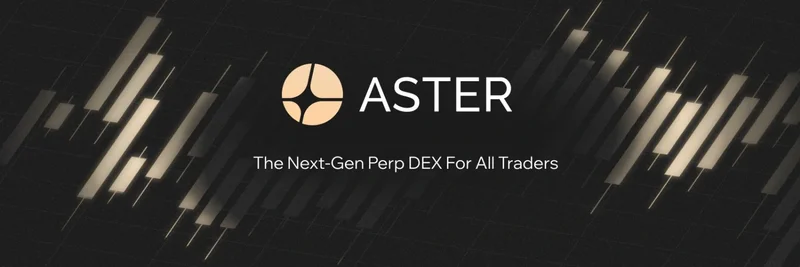Aster (ASTER) is a next‑gen decentralized exchange (DEX) built primarily on BNB Chain, aiming to bring CEX‑level tools to a self‑custodial DeFi experience. Launched in September 2025, Aster blends advanced perpetuals infrastructure with multi‑asset liquidity—an outcome of its late‑2024 merger between Astherus and APX Finance. The project has backing from YZi Labs (formerly Binance Labs) and a public nod from CZ, boosting early visibility and confidence.
Perpetuals, in simple terms, are futures‑like contracts with no expiry. Aster’s take is to pair pro‑grade derivatives with capital efficiency and privacy features in a DEX format.
What makes Aster different
- Multi‑chain access without manual bridging: Deep integration with BNB Chain plus support for Ethereum, Solana, and Arbitrum.
- 1,001x high‑leverage perps: Experienced traders can take amplified positions up to 1,001x.
- Yield‑bearing collateral (Trade & Earn): Use yield‑generating assets such as liquid‑staking tokens (e.g., asBNB) or yield‑bearing stablecoins (e.g., USDF) as margin so your collateral can earn while you trade. See examples referenced by Coinbase Learn.
- Hidden Orders (dark pools): A privacy‑focused order type where orders remain invisible until execution to reduce front‑running and improve fills for large trades. Aster highlights this in its feature posts.
- Dual trading modes: A one‑click Simple Mode for speed, and a Pro Mode with a full order book, grid trading, and multi‑asset margin support.
- Aster Chain (on roadmap): A performance‑oriented L1 focused on privacy‑preserving derivatives with sub‑second finality, lower gas, and better scalability. Aster’s presence across BNB Chain assets is tracked by venues like OKX blockchains.
Dark pools, explained simply: they’re private order mechanisms where details aren’t broadcast to the public mempool until execution, helping reduce MEV bots and slippage for size.
ASTER token: supply, utility, and incentives
- Standard and supply: ASTER is a BEP‑20 token on BNB Chain with a total supply of 8,000,000,000, launched on September 17, 2025. Source: Phemex news brief.
- Core utilities:
- Governance over upgrades, fee structures, and partnerships
- Trading fee discounts for holders
- Rewards and airdrops to drive participation
- Staking to encourage long‑term alignment
- Deflationary buybacks funded by a portion of platform fees
- Distribution (community‑first design):
- 53.5%: airdrops and community incentives
- 30%: ecosystem and community development
- 7%: treasury
- 5%: team
- 4.5%: liquidity and listings
In practice, this model aligns long‑term community incentives (airdrops, staking, and rewards) with the DEX’s growth flywheel.
Market traction, listings, and where to trade ASTER
Aster’s rapid growth out of the gate saw strong revenue days that rivaled established perps venues like Hyperliquid. ASTER was listed on Binance on October 6, 2025, with pairs against USDT, USDC, and TRY. Binance applied a Seed Tag, signaling higher‑than‑normal risk for a new, innovative listing.
For research and trading, you can also use:
- GMGN.AI’s dedicated ASTER page for real‑time analytics and trading: https://gmgn.ai/bsc/token/fV1R5sZ5_0x000ae314e2a2172a039b26378814c252734f556a
- The project overview on CoinMarketCap
Note: When exploring any new token, compare prices, liquidity, fees, and slippage across platforms before executing trades.
Why traders care: capital efficiency + privacy
Two standout ideas define Aster’s thesis:
- Earn on your margin: Using yield‑bearing collateral lets traders keep capital productive even when it’s posted as margin, which can improve overall return profiles during active trading.
- Hidden execution: With Hidden Orders, larger traders can avoid broadcasting intent, lowering the risk of adverse price movement from bots and opportunistic actors.
Combined with multi‑asset margin and a pro‑style interface, Aster targets the “CEX feel” inside a DeFi stack.
Risks and considerations
- High leverage: 1,001x magnifies both gains and losses. Manage risk tightly and consider smaller position sizes and robust stop‑loss rules.
- New‑token volatility: The Seed Tag on Binance implies elevated volatility and evolving liquidity.
- Smart contract and cross‑chain risk: As a multi‑chain DEX with advanced order types, Aster carries the usual DeFi risks—contract bugs, oracle dependencies, and chain congestion.
Outlook and roadmap notes
The planned Aster Chain—emphasizing high throughput, low fees, and privacy for derivatives—could further compress execution costs and enhance user experience if delivered as described. If adoption sustains and incentives align with genuine usage (not just yield‑seeking), Aster can remain competitive against leading perps venues on and off BNB Chain.
Quick facts
- Token: ASTER (BEP‑20), address: 0x000ae314e2a2172a039b26378814c252734f556a
- Total supply: 8,000,000,000
- Launch: September 17, 2025
- Venue scope: Multi‑chain (BNB Chain first), perps + spot, with privacy‑focused order types
Useful links
- ASTER on Binance (spot): ASTER/USDT
- Project overview: Aster on CoinMarketCap
- Aster features and background: Binance Square post
- Decrypt coverage of leverage and launch: Aster DeFi exchange on BNB Chain
- ASTER analytics and trading: https://gmgn.ai/bsc/token/fV1R5sZ5_0x000ae314e2a2172a039b26378814c252734f556a
This article is for informational purposes only and not financial advice. Always do your own research.


